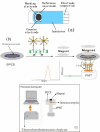A renewable and ultrasensitive electrochemiluminescence immunosenor based on magnetic RuL@SiO2-Au~RuL-Ab2 sandwich-type nano-immunocomplexes
- PMID: 22164043
- PMCID: PMC3231728
- DOI: 10.3390/s110807749
A renewable and ultrasensitive electrochemiluminescence immunosenor based on magnetic RuL@SiO2-Au~RuL-Ab2 sandwich-type nano-immunocomplexes
Abstract
An ultrasensitive and renewable electrochemiluminescence (ECL) immunosensor was developed for the detection of tumor markers by combining a newly designed trace tag and streptavidin-coated magnetic particles (SCMPs). The trace tag (RuL@SiO(2)-Au~RuL-Ab2) was prepared by loading Ru(bpy)(3)(2+)(RuL)-conjuged secondary antibodies (RuL-Ab2) on RuL@SiO(2) (RuL-doped SiO(2)) doped Au (RuL@SiO(2)-Au). To fabricate the immunosensor, SCMPs were mixed with biotinylated AFP primary antibody (Biotin-Ab1), AFP, and RuL@SiO2-Au~RuL-Ab2 complexes, then the resulting SCMP/Biotin-Ab1/AFP/RuL@SiO2-Au~RuL-Ab2 (SBAR) sandwich-type immunocomplexes were absorbed on screen printed carbon electrode (SPCE) for detection. The immunocomplexes can be easily washed away from the surface of the SPCE when the magnetic field was removed, which made the immunosensor reusable. The present immunosensor showed a wide linear range of 0.05-100 ng mL(-1) for detecting AFP, with a low detection limit of 0.02 ng mL(-1) (defined as S/N = 3). The method takes advantage of three properties of the immunosensor: firstly, the RuL@SiO(2)-Au~RuL-Ab2 composite exhibited dual amplification since SiO(2) could load large amount of reporter molecules (RuL) for signal amplification. Gold particles could provide a large active surface to load more reporter molecules (RuL-Ab2). Accordingly, through the ECL response of RuL and tripropylamine (TPA), a strong ECL signal was obtained and an amplification analysis of protein interaction was achieved. Secondly, the sensor is renewable because the sandwich-type immunocomplexes can be readily absorbed or removed on the SPCE's surface in a magnetic field. Thirdly, the SCMP modified probes can perform the rapid separation and purification of signal antibodies in a magnetic field. Thus, the present immunosensor can simultaneously realize separation, enrichment and determination. It showed potential application for the detection of AFP in human sera.
Keywords: [Ru(bpy)3]2+@SiO2-Au; alpha-fetoprotein; electrochemiluminescence; sandwich-type immunoreaction; screen printed carbon electrode.
Figures










Similar articles
-
The sandwich-type electrochemiluminescence immunosensor for α-fetoprotein based on enrichment by Fe3O4-Au magnetic nano probes and signal amplification by CdS-Au composite nanoparticles labeled anti-AFP.Anal Chim Acta. 2012 Oct 9;746:107-13. doi: 10.1016/j.aca.2012.08.036. Epub 2012 Aug 28. Anal Chim Acta. 2012. PMID: 22975187
-
A Novel Electrochemiluminescence Immunosensor for the Analysis of HIV-1 p24 Antigen Based on P-RGO@Au@Ru-SiO₂ Composite.ACS Appl Mater Interfaces. 2015 Nov 11;7(44):24438-45. doi: 10.1021/acsami.5b08154. Epub 2015 Oct 29. ACS Appl Mater Interfaces. 2015. PMID: 26488492
-
Ru(bpy)3(2+)-doped silica nanoparticles labeling for a sandwich-type electrochemiluminescence immunosensor.Biosens Bioelectron. 2010 Mar 15;25(7):1851-5. doi: 10.1016/j.bios.2009.12.027. Epub 2009 Dec 29. Biosens Bioelectron. 2010. PMID: 20074928
-
Electrochemical immuno-biosensors for the detection of the tumor marker alpha-fetoprotein: A review.Talanta. 2024 May 1;271:125638. doi: 10.1016/j.talanta.2024.125638. Epub 2024 Jan 18. Talanta. 2024. PMID: 38237279 Review.
-
Expanding the scope of chemiluminescence in bioanalysis with functional nanomaterials.J Mater Chem B. 2019 Dec 14;7(46):7257-7266. doi: 10.1039/c9tb01029g. Epub 2019 Sep 23. J Mater Chem B. 2019. PMID: 31544920 Free PMC article. Review.
Cited by
-
Electrochemiluminescence Biosensors Using Screen-Printed Electrodes.Biosensors (Basel). 2020 Sep 9;10(9):118. doi: 10.3390/bios10090118. Biosensors (Basel). 2020. PMID: 32916838 Free PMC article. Review.
-
An ultrasensitive electrochemiluminescence immunoassay for carbohydrate antigen 19-9 in serum based on antibody labeled Fe3O4 nanoparticles as capture probes and graphene/CdTe quantum dot bionanoconjugates as signal amplifiers.Int J Mol Sci. 2013 May 17;14(5):10397-411. doi: 10.3390/ijms140510397. Int J Mol Sci. 2013. PMID: 23685872 Free PMC article.
References
-
- Xiao Z, Prieto D, Conrads TP, Veenstra TD, Issaq HJ. Proteomic patterns: Their potential for disease diagnosis. Mol. Cell. Endocrinol. 2005;230:95–106. - PubMed
-
- Weston AD, Hood L. Systems biology, proteomics, and the future of health care: Toward predictive, preventative, and personalized medicine. J. Proteome Res. 2004;3:179–196. - PubMed
-
- Kitano H. Systems biology: A brief overview. Science. 2002;295:1662–1664. - PubMed
-
- Wright LM, Kreikemerier JT, Fimmel CJ. A concise review of serum markers for hepatocellular cancer. Cancer Detect. Prev. 2007;31:35–44. - PubMed
-
- Chou SF, Hsu WL, Hwang JM, Chen CY. Determination of [alpha]-fetoprotein in human serum by a quartz crystal microbalance-based immunosensor. Clin. Chem. 2002;48:913–918. - PubMed
Publication types
MeSH terms
Substances
LinkOut - more resources
Full Text Sources
Miscellaneous

